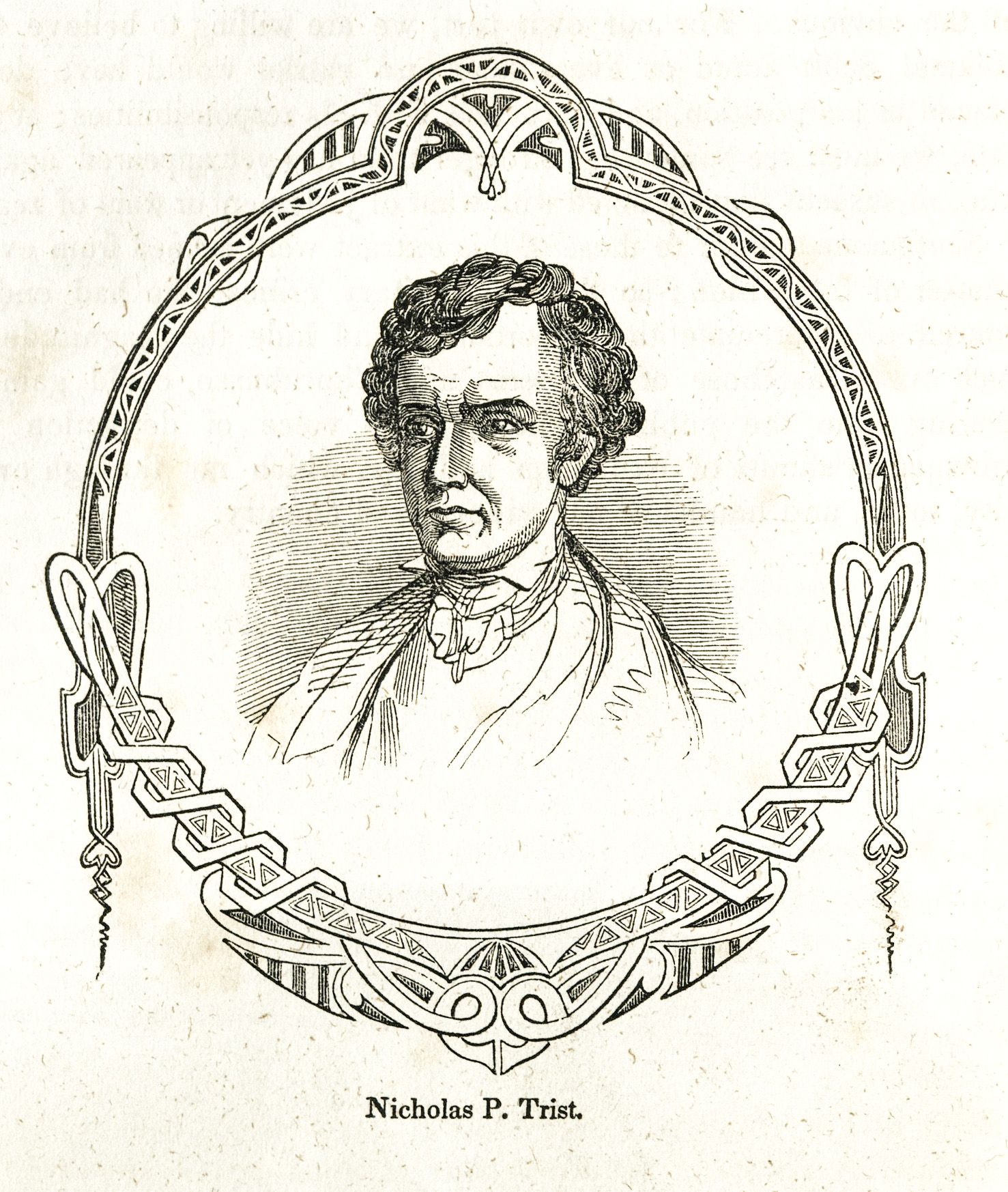Nicholas Philip Trist
June 2, 1800—February 11, 1874
Nicholas P. Trist, the American diplomat who negotiated the treaty that ended the U.S.-Mexico War, was born on June 2, 1800, in Charlottesville, Virginia. His father was the first tax collector at the port of New Orleans. In his youth, Trist was taken to live in Louisiana, from where he went to the U.S. military academy at West Point in 1818. From 1819 to 1820 cadet Trist served as acting assistant teacher of French. Although he did well enough on his exams in Natural Philosophy (Science), Chemistry and Drawing to be ranked second in his class, Trist resigned from the academy in 1821 and returned to his native Virginia, where he studied law under former President Thomas Jefferson.
On September 10, 1824 Trist married Jefferson's granddaughter, Virginia Jefferson Randolph, at Monticello, the former president's home near Charlottesville. In 1826, Trist was one of two grandsons-in-law named in Jefferson's will.
In 1828 Trist became First Clerk in the U.S. Treasury Department. After Andrew Jackson became President, he appointed Trist to the State Department. In 1831, the young clerk became Jackson's private secretary. Three years later, the President appointed Trist the U.S. consul to Havana, where in 1839 he was accused of insulting American seamen and conspiring with Spanish authorities to have them unlawfully imprisoned. Trist was also suspected of embezzling large sums of money and helping Portuguese mariners circumvent anti-slave trade laws, a charge which appears to have been genuine. Efforts to have him recalled were unsuccessful, however, and Trist remained in Havana until 1845, when he returned to Washington, where newly-installed President James K. Polk appointed him Chief Clerk of the State Department.
In April 1847, nearly a year after the U.S.-Mexico War began, Polk sent Trist to Mexico as special envoy to make a treaty of peace should General Winfield Scott's invasion force achieve victory by capturing Mexico City. At first, Scott and Trist did not like one another but eventually their relationship improved and in time a genuine friendship evolved, which outlasted the war.
Polk empowered Trist to offer the Mexican government up to $30 million for New Mexico and all of California, including Baja (Lower) California, as well as a right of way through the Isthmus of Tehuantepec. Mexico would also have to accept the Rio Grande as the boundary of Texas. In addition, the U.S. would agree to assume Mexico's unpaid debts to U.S. citizens. Trist was told that if the Mexicans were reluctant to concede the loss of both Californias and to grant a right of way across Tehuantepec, those conditions were dispensable, but the amount offered would be lowered to $15 or $20 million.
In August 1847, following the battles of Contreras and Churubusco, Santa Anna asked for an armistice, during which time Trist attempted to negotiate; but before he could make any progress, fighting resumed. It was therefore not until after American forces had captured Mexico City in mid-September and Santa Anna was ousted that Trist was finally able to begin his work.
Just as he was beginning to enter into negotiations with the provisional Mexican government that had been hastily organized at the town of Querétaro under a new President, Manuel Peña y Peña, Trist received word from Secretary of State James Buchanan that he (Trist) had been recalled by an impatient President Polk. Buchanan's dispatch stated further that if the Mexicans wanted peace, they would have to send an emissary to the United States. Realizing that to abandon his work and leave Mexico at that crucial juncture would almost certainly have negative consequences for both countries, Trist decided to ignore the recall, which General Scott and all three Mexican negotiators, Luis G. Cuevas, Bernardo Couto, and Miguel Atristain, encouraged him to do.
On February 2, 1848, Trist signed the Treaty of Guadalupe Hidalgo on behalf of the United States while Cuevas, Couto, and Atristain signed for Mexico. The treaty's most far-reaching provisions included recognition by Mexico of the Rio Grande as the boundary of Texas, the United States government's assumption of $3 million Mexico owed to private U.S. citizens, and Mexico's agreement to sell Upper California and New Mexico, a vast expanse that makes up the present-day states of California, Arizona, Nevada, Utah, New Mexico, and part of Colorado, for $15 million.
When the treaty reached Washington, Polk was outraged that Trist, who technically had no authority to make an agreement with Mexico on account of his recall, had ignored the President's order. At first, Polk considered discarding the agreement but realizing that all his principal war goals had been accomplished and that the country was in no mood to prolong the conflict, he sent it to the Senate, which ratified the treaty on March 10, 1848. Both houses of the Mexican Congress ratified it on May 19.
Despite the fact that Trist had negotiated terms that included nearly everything Polk had wanted, the President treated him contemptuously. After he returned to the United States, Trist learned that Polk had issued an order stopping his salary effective November 16, 1847, which meant that he would not be paid for the bulk of the time he was negotiating with Mexico's representatives.
For more than twenty years Trist said nothing about Polk's unjust treatment, but in 1870, after reportedly living in poverty for several years, he asked Congress to compensate him for his entire time in Mexico. On April 20, 1871 a bill granting the former diplomat $14,559 was passed by both houses and signed by President Grant.
After spending the last years of his life as postmaster at Alexandria, Virginia, Trist died on February 11, 1874. He was buried at Ivy Hill Cemetery in Alexandria.
Bibliography
Ohrt, Wallace. Defiant Peacemaker: Nicholas Trist in the Mexican War. College Station, 1998.
Drexler, Robert W. Guilty of Making Peace: A Biography of Nicholas P. Trist. Lanham, 1991.

